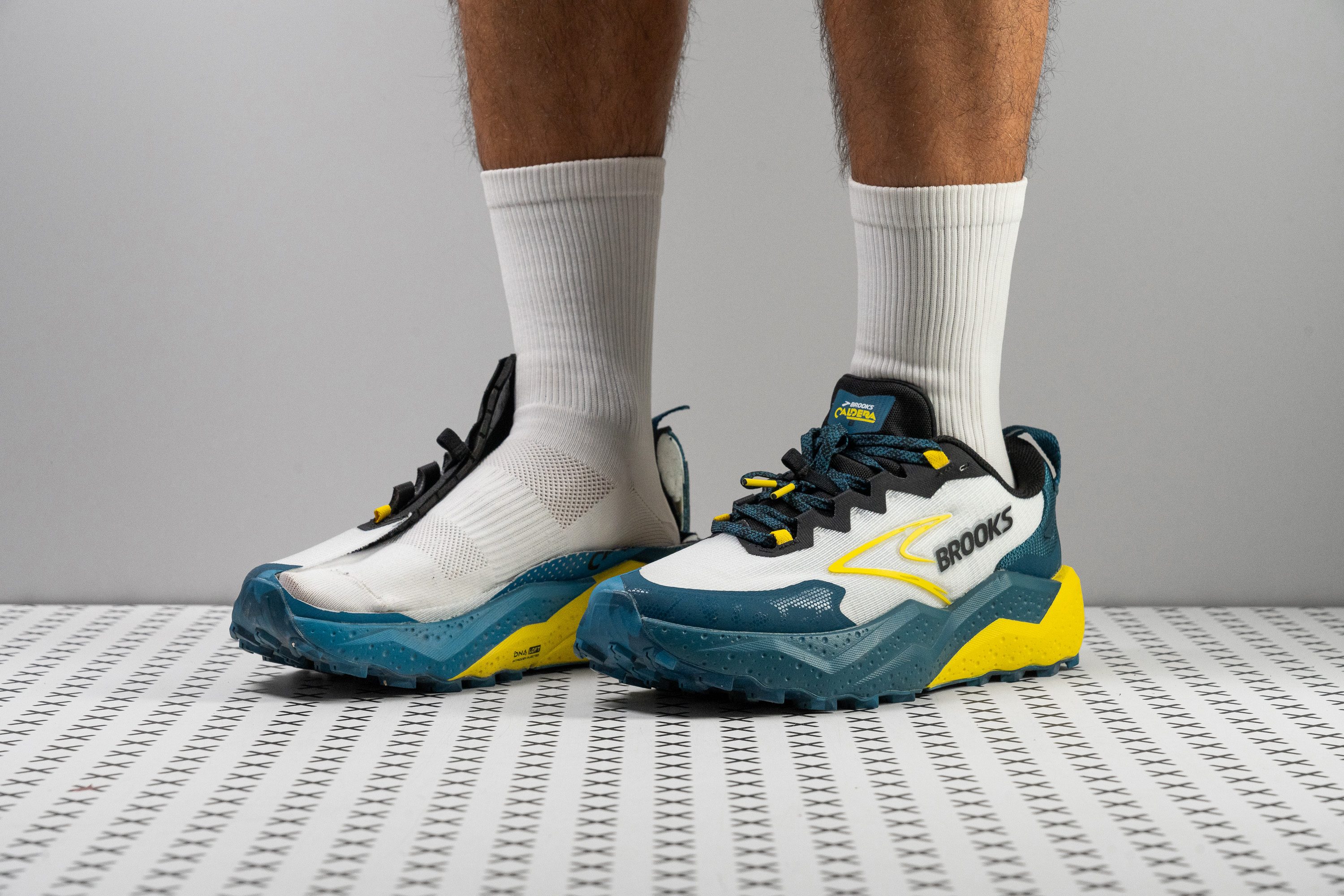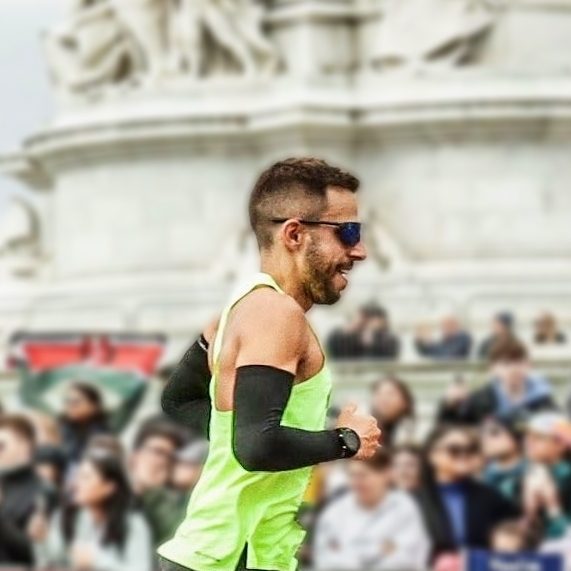Nuestra conclusión
Pros
- Muy estables
- Pisada fluida y cómoda
- Versátiles en terrenos fáciles y moderados
- Ajuste seguro y confiable
- Precio justo y razonable
- Tracción fiable
- Estética más limpia y refinada
Contras
- Siguen siendo pesadas
- Necesitan más amortiguación
- Talón voluminoso y demasiado ancho
- Solo para ritmos lentos
Veredicto de los usuarios
- Top 21% entre zapatillas de trail running
- Top 21% entre zapatillas de running Brooks
Comparativa
Las zapatillas de running más parecidas
+ + Añadir unas zapatillas | |||||
|---|---|---|---|---|---|
| Puntuación global | 89 Notables | 91 Excelentes | 85 Buenas | 90 Excelentes | |
| Precio | 150 € | 150 € | 170 € | 140 € | |
| Terreno de trail | SencilloModerado | SencilloModerado | Sencillo | Sencillo | |
| Absorción de impactos | Moderada | Alta | Moderada | - | |
| Retorno de energía | Moderado | Moderado | Moderado | - | |
| Tracción | Alta | - | Alta | - | |
| Arch support | Neutral | Neutral | Neutral | Neutral | |
| Peso laboratorio Peso marca | 10.9 oz / 309g 10.9 oz / 309g | 11 oz / 312g 11 oz / 311g | 11 oz / 312g 10.9 oz / 309g | 9.7 oz / 275g 10.8 oz / 307g | |
| Drop laboratorio Drop marca | 8.8 mm 6.0 mm | 10.9 mm 9.5 mm | 6.5 mm 6.0 mm | 11.6 mm 6.0 mm | |
| Técnica de carrera | TalónMedio/antepié | Talón | Medio/antepié | Talón | |
| Talla | Tallan bien | Tallan bien | - | Tallan bien | |
| Rigidez de la mediasuela | Blanda | Blanda | Blanda | Equilibrada | |
| Diferencia de la rigidez de la mediasuela en frío | Grande | Normal | Normal | Normal | |
| Placa | ✗ | Rock plate | ✗ | ✗ | |
| Durabilidad de la parte delantera | Mala | Muy mala | Decente | Buena | |
| Durabilidad del acolchado del talón | Alta | Alta | Baja | Alta | |
| Durabilidad de la suela exterior | Decente | Decente | Decente | Buena | |
| Transpirabilidad | Media | Media | Media | Baja | |
| Anchura / ajuste | Media | Media | Media | Media | |
| Anchura de la parte delantera | Media | Media | Media | Media | |
| Flexibilidad | Moderada | Moderada | Moderada | Moderada | |
| Rigidez torsional | Rígidas | Moderadas | Rígidas | Rígidas | |
| Rigidez del contrafuerte del talón | Rígido | Moderado | Rígido | Rígido | |
| Profundidad del dibujo de la suela | 3.6 mm | 3.4 mm | 3.5 mm | 3.3 mm | |
| Altura de la suela en la zona del talón laboratorio Altura de la suela en la zona del talón marca | 36.7 mm 39.0 mm | 38.3 mm 38.0 mm | 37.6 mm 36.0 mm | 35.8 mm 30.0 mm | |
| Antepié laboratorio Antepié marca | 27.9 mm 33.0 mm | 27.4 mm 28.5 mm | 31.1 mm 30.0 mm | 24.2 mm 24.0 mm | |
| Anchuras disponibles | Estándar | Estándar | Estándar | Estándar | |
| Estación | Todas las estaciones | Todas las estaciones | Todas las estaciones | Todas las estaciones | |
| Removable insole | ✓ | ✓ | ✓ | ✓ | |
| Orthotic friendly | ✓ | ✓ | ✓ | ✓ | |
| Clasificación | #88 Top 24% | #35 Top 10% | #200 46% inferior | #48 Top 13% | |
| Popularidad | #173 Top 47% | #136 Top 37% | #186 Top 50% | #224 39% inferior |
Quién debería comprárselas
Las Brooks Caldera 8 te van a encantar si:
- Estás buscando unas zapatillas de trail con una buena estabilidad y una pisada cómoda.
- Te gustaron las Caldera 7 y quieres unas sucesoras que se sientan de forma parecida, con solo un par de reajustes básicos.
- Necesitas un modelo de trail versátil y con una tracción confiable para terrenos fáciles y moderados.
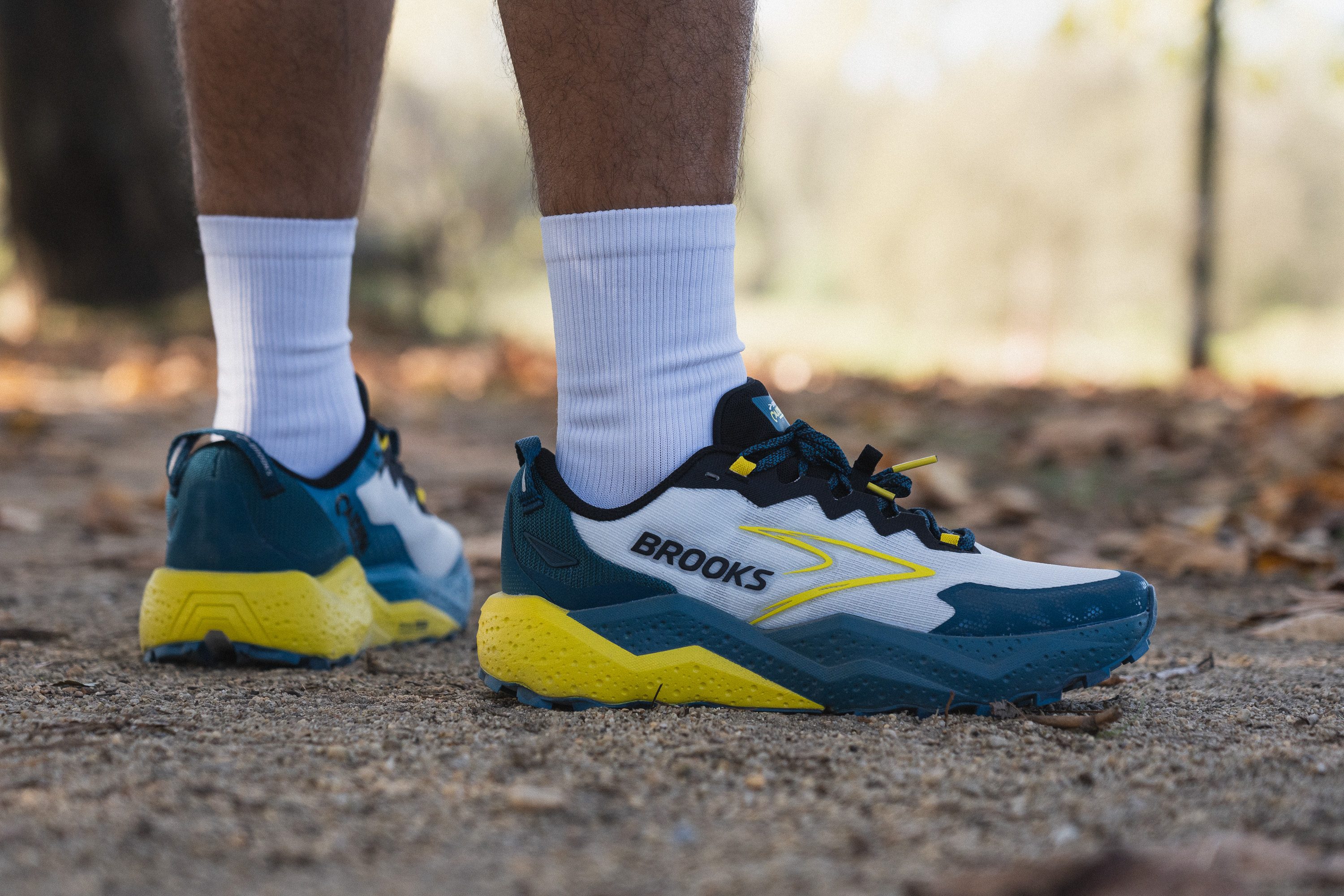
Quién NO debería comprárselas
Creemos que las Caldera 8 no son la mejor opción si lo que estás buscando es una amortiguación máxima. En el laboratorio, descubrimos que tanto su absorción de impactos como la altura de su mediasuela se quedan cortas, y según nuestros datos, opciones como las HOKA Mafate 5 o las ASICS Trabuco Max 4 ofrecen una pisada más amortiguada.
También creemos que no son la mejor opción para los corredores con pies anchos. Después de nuestras pruebas, descubrimos que su parte delantera no tiene el espacio necesario para que podamos estirar los dedos de forma natural; las Altra Olympus 6 o las Topo Ultraventure 4 son mejores opciones en ese caso.
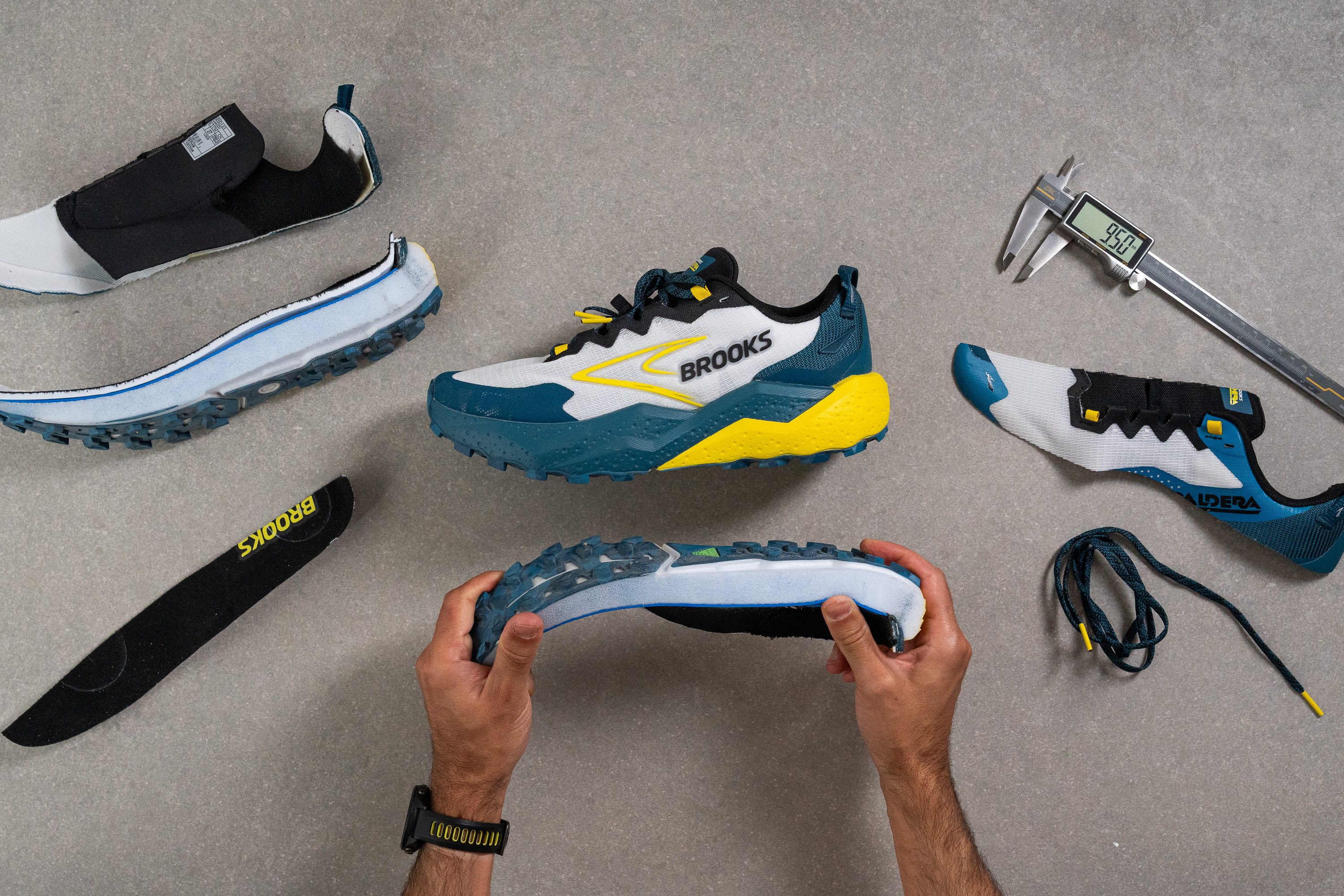
Amortiguación
Shock absorption
Las Caldera 8 toman un rumbo que, sinceramente, no nos esperábamos. En los últimos años, casi todas las zapatillas de running que han salido han ido aumentando su amortiguación, pero este modelo pasa del tema. De hecho, pasa incluso más que las Caldera 7.
Cuando analizamos su absorción de impactos en nuestro laboratorio, la máquina marcó 129 SA en el talón y 111 SA en el antepié... resultados un poco decepcionantes para unas zapatillas que, según la marca, están ultraamortiguadas, la verdad. Nosotros creemos que las Caldera 8 no son, ni de lejos, unas zapatillas con amortiguación máxima.

| Caldera 8 | 129 SA |
| Media | 122 SA |
Energy return
Después de hacerles pruebas a las Caldera 8, descubrimos que utilizan la misma espuma DNA Loft v3 que sus hermanas, las Cascadia 19, así que en verdad tampoco podemos decir que esta mejora sea una locura.
Este compuesto de EVA supercrítica ofrece una pisada suave y cómoda, aunque su retorno de energía no es impresionante, alcanzando solo un 56,9 % en el talón y un 58,7 % en el antepié. Y aunque las Caldera 8 tienen un precio razonable, la verdad es que no nos importaría pagar un poco más por una versión que tuviese un poco de la espuma DNA Gold de PEBA de Brooks, ya que aumentaría la reactividad.
| Caldera 8 | 56.9% |
| Media | 55.6% |
Altura de la suela en la zona del talón
Las Caldera 8 tienen una suela en el talón exactamente de la misma altura que las Caldera 7, con 36,7 mm.
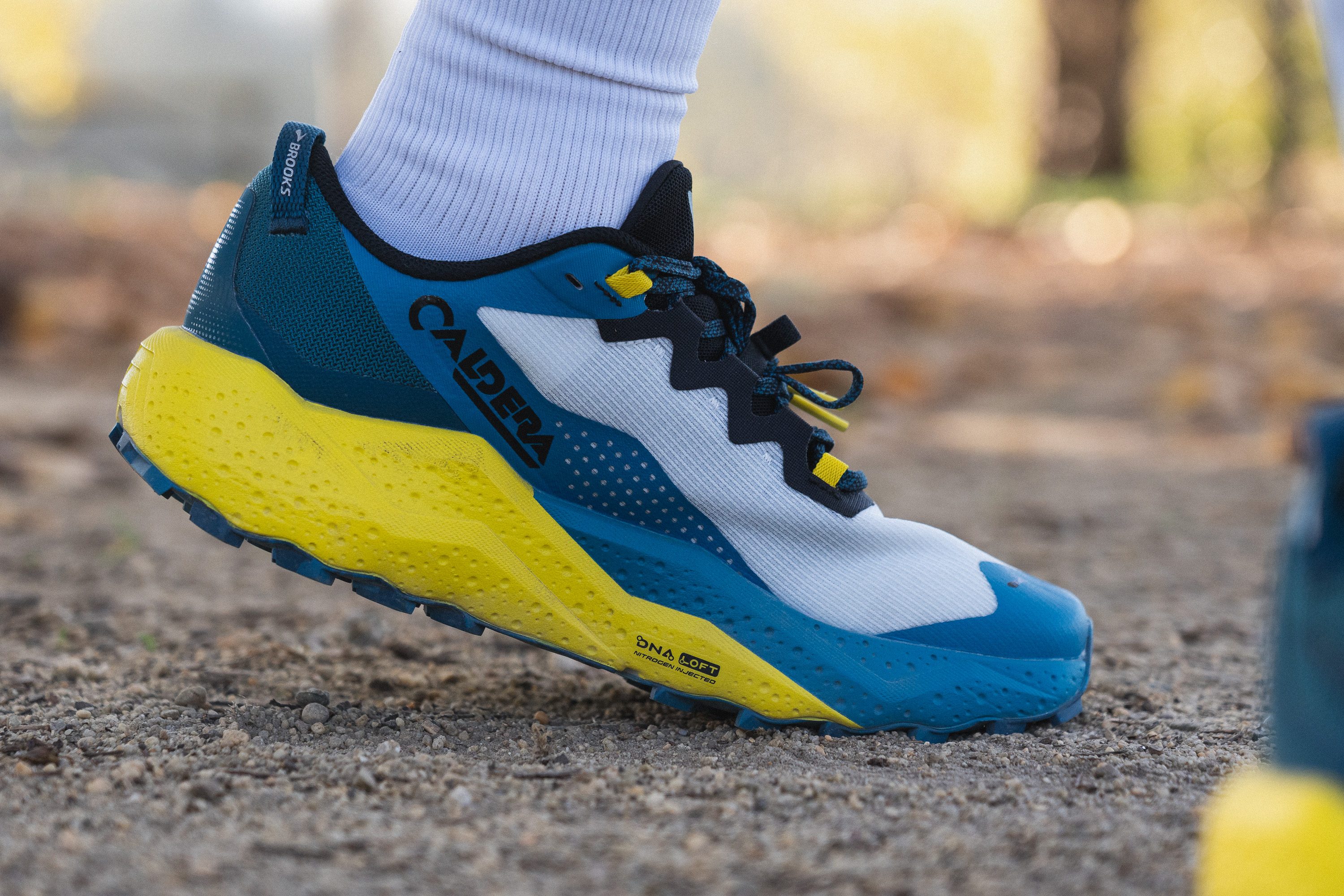
Una vez más, Brooks tiene que tomar medidas si quiere que la línea Caldera permanezca en la categoría de máxima amortiguación. Con solo 36,7 mm, ya no consigue entrar en este grupo, y es que ahora es esencial acercarse o incluso superar los 40 mm, sobre todo porque las Cascadia ya tienen el grupo de amortiguación media cubierto.
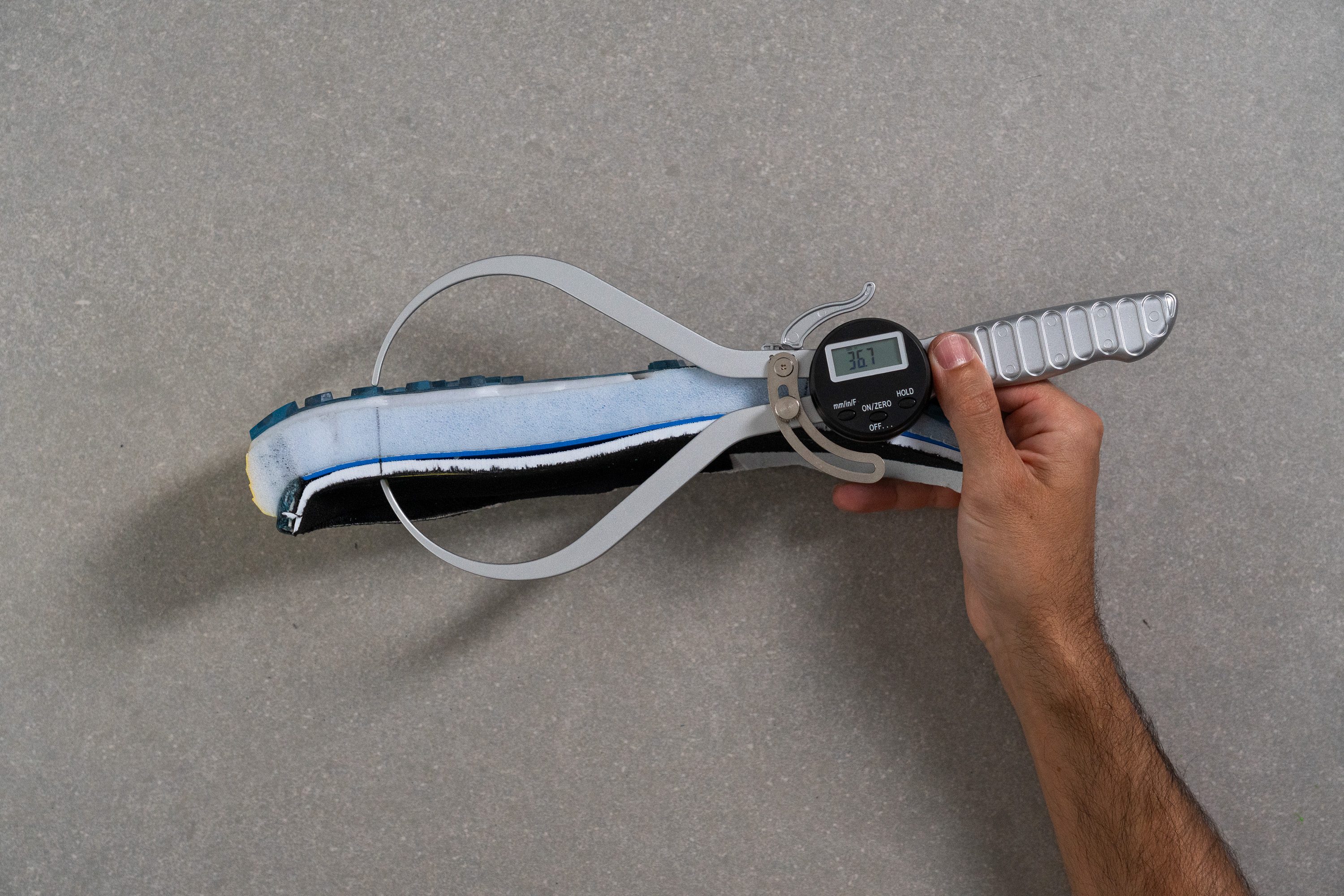
| Caldera 8 | 36.7 mm |
| Media | 32.6 mm |
Altura de la suela en el antepié
La parte delantera ofrece un poco más de amortiguación que la media, con 27,9 mm, aunque todavía no alcanza los estándares maximalistas actuales. De todos modos, consigue ofrecer un equilibrio sólido que debería adaptarse cómodamente a la mayoría de los corredores.
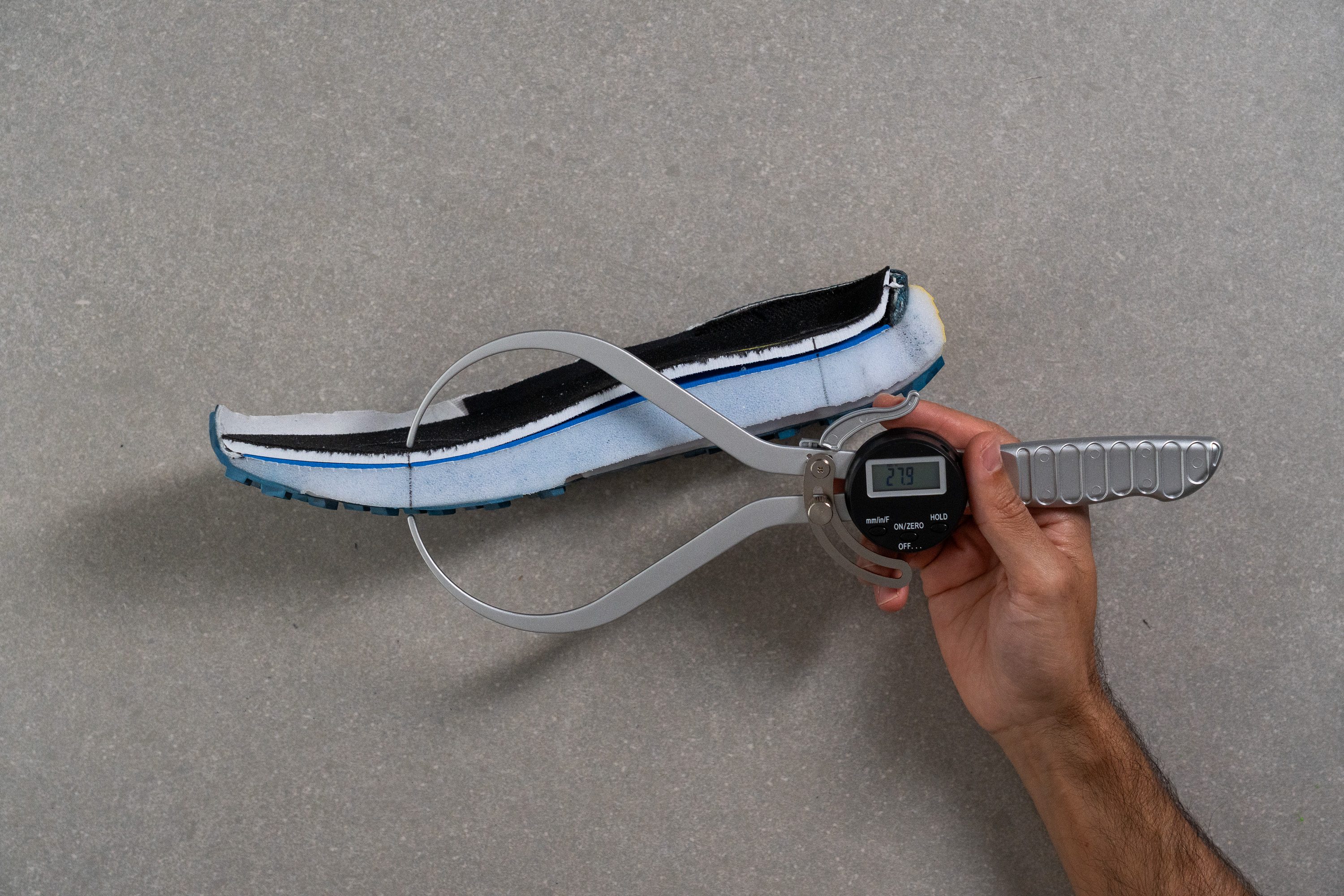
| Caldera 8 | 27.9 mm |
| Media | 25.1 mm |
Drop
Con un drop de 8,8 mm, las Caldera 8 superan ese drop de 6 mm del que habla Brooks. Pero bueno, que esto no es algo negativo, ya que la geometría de las zapatillas claramente favorece a los talonadores, y esto no hace más que confirmarlo.
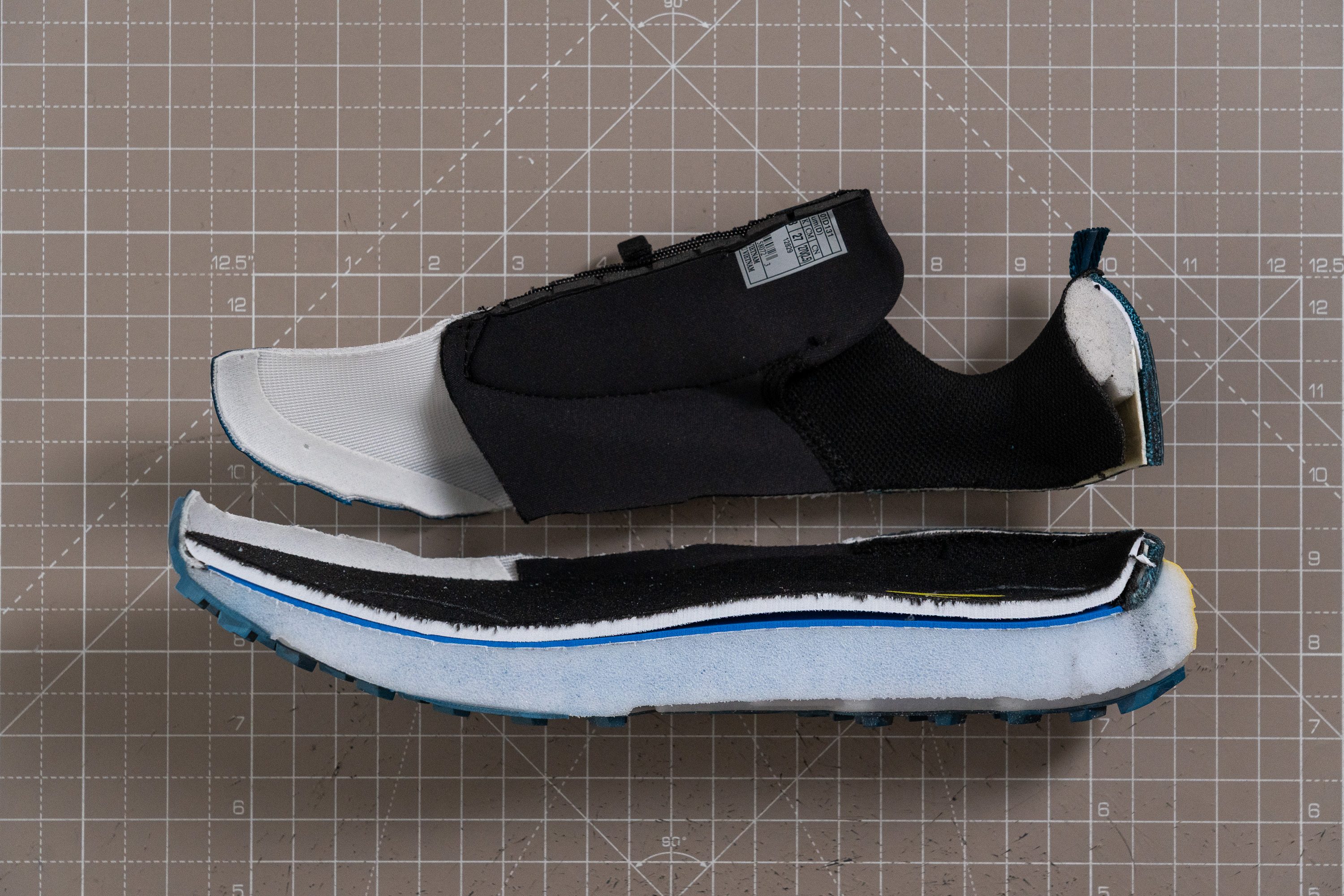
| Caldera 8 | 8.8 mm |
| Media | 7.5 mm |
Suavidad de la mediasuela
Pusimos a prueba la espuma DNA Loft v3 inflada con nitrógeno y descubrimos que se sigue centrando en la comodidad. Se siente un poquito blanda, como confirmó nuestro durómetro al marcar 18,0 HA.
Eso sí, esto hace que sea un 16 % más firme que la versión 7, ya que Brooks se encargó de refinar un poquito su fórmula para conseguir más estabilidad para el trail. Personalmente, nosotros creemos que este retoque es muy acertado, ya que hace que la pisada sea más segura en los terrenos irregulares, sin perder la sensación habitual.

| Caldera 8 | 18.0 HA |
| Media | 21.9 HA |
Rocker
Las Caldera 8 tienen un rocker moderado que ofrece transiciones suaves sin sentirse exageradas. No tienen un biselado del talón definido, aunque la parte de atrás se curva un poco hacia arriba, lo que ayuda a los talonadores a disfrutar de una pisada más fluida, manteniendo al mismo tiempo una geometría natural y equilibrada en terrenos variados.
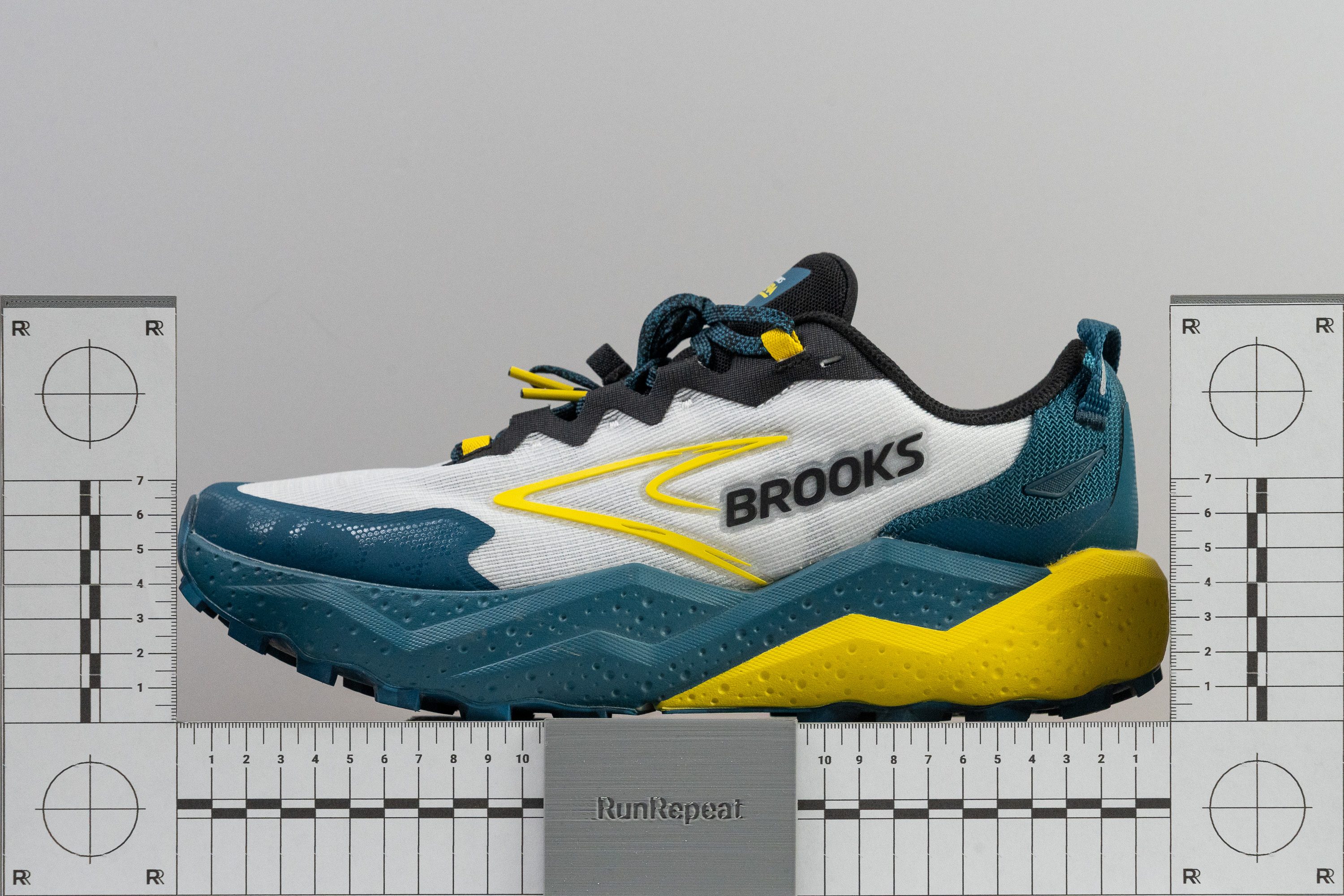
Tallaje y ajuste
Talla
Las Brooks Caldera 8 tallan bien (52 votos).
Anchura / Ajuste
Desde que nos pusimos por primera vez las nuevas Caldera, sentimos que su ajuste se iba a adaptar a la mayoría de corredores. Como siempre, preparamos nuestro gel para hacer un molde de su interior.
Cuando se solidificó y pudimos medirlo, nuestro calibre marcó 94,6 mm de ancho, así que el ajuste es confiable y estándar.
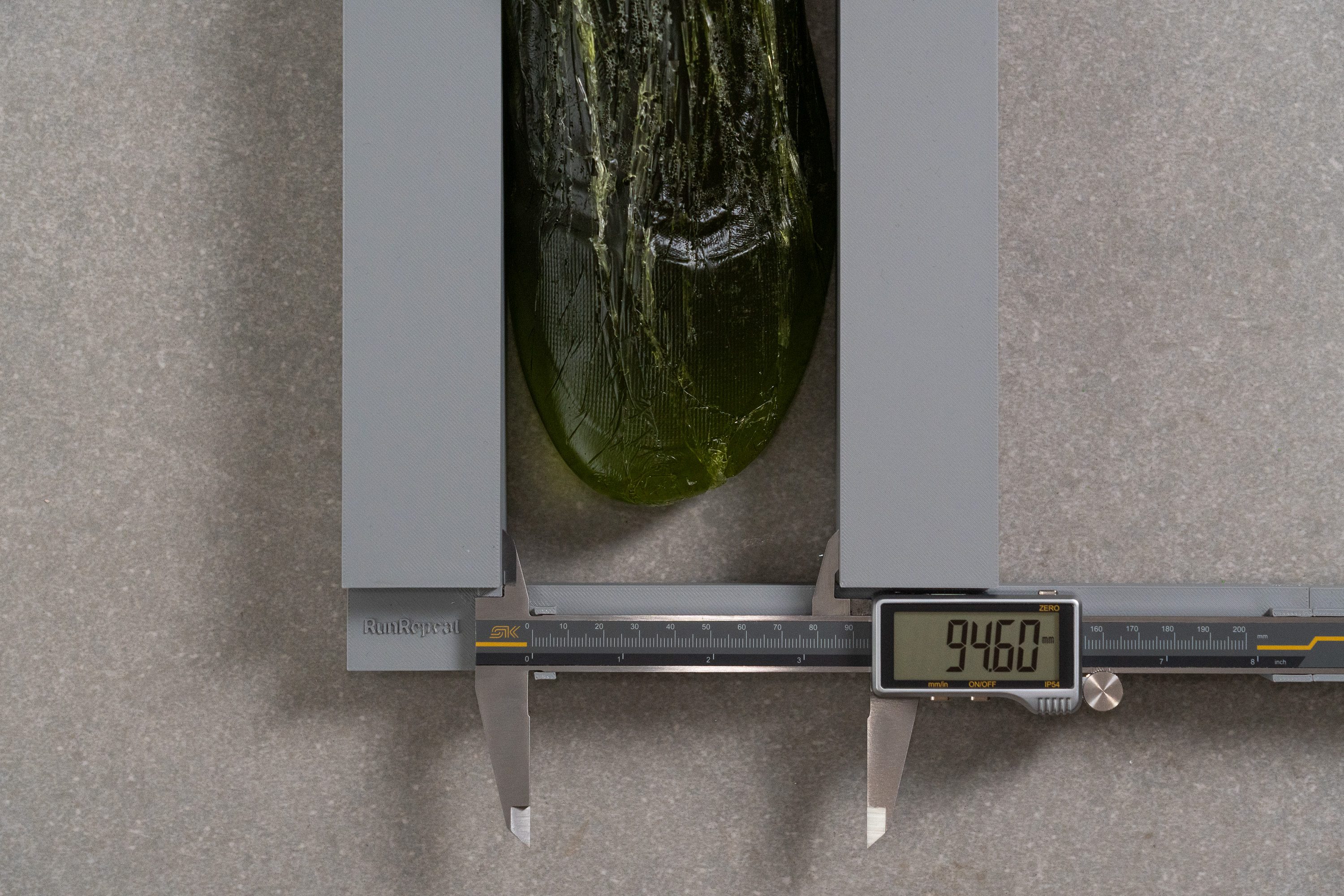
| Caldera 8 | 94.6 mm |
| Media | 95.7 mm |
Anchura de la parte delantera
La parte delantera también está cerca de la media con sus 73,0 mm, ofreciéndonos un ajuste parecido al de muchas zapatillas de entrenamiento diario para asfalto. Eso sí, el espacio para los dedos no es más que decente, así que no te esperes nada tan amplio como unas Altra.
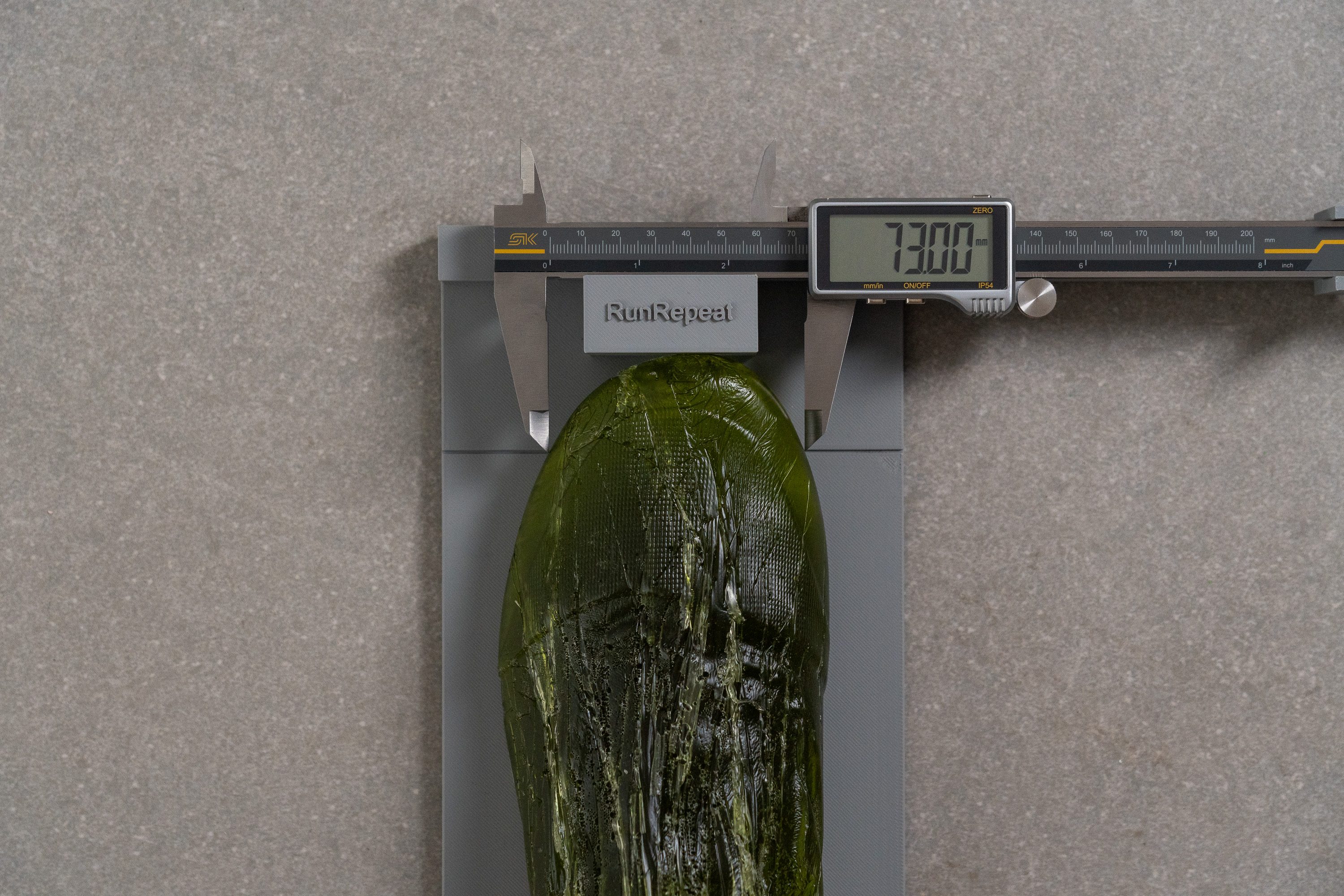
| Caldera 8 | 73.0 mm |
| Media | 74.7 mm |
Altura de la parte delantera
Los corredores con pies voluminosos o a los que no les gusta sentir presión en los dedos deberían estar cómodos con este modelo.
Su parte delantera tiene una altura de 26,4 mm, así que ofrece el espacio vertical justo para poder mover los dedos de forma natural, al mismo tiempo que garantiza un ajuste seguro y confiable.
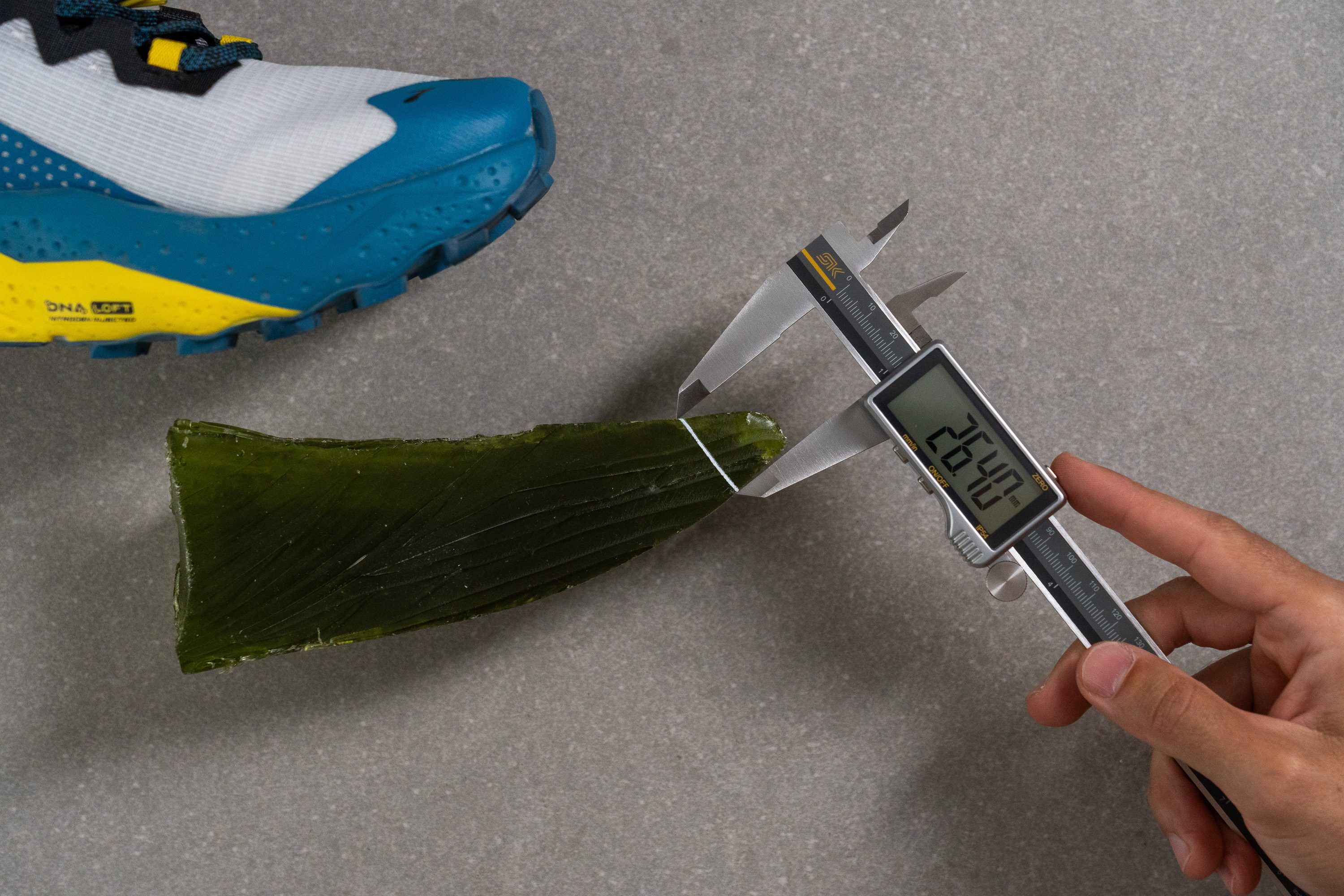
| Caldera 8 | 26.4 mm |
| Media | 27.1 mm |
Tracción / Agarre
Tracción en el antepié
La verdad es que nos quedamos contentísimos con su agarre, que se llevó un sólido resultado de 0,59. Esto hace que las zapatillas sean fiables incluso en las superficies complicadas, como pueden ser las rocas mojadas. Está claro que Brooks sigue perfeccionando el compuesto TrailTack Green, ¡y lo está consiguiendo!
| Caldera 8 | 0.59 |
| Media | 0.60 |
Profundidad del dibujo de la suela
Las Caldera 8 presumen de tacos versátiles que funcionan bien en terrenos fáciles y que pueden lidiar con algunos tramos moderadamente técnicos. Pero con solo 3,6 mm de profundidad, se les complican las zonas técnicas o los caminos con barro.
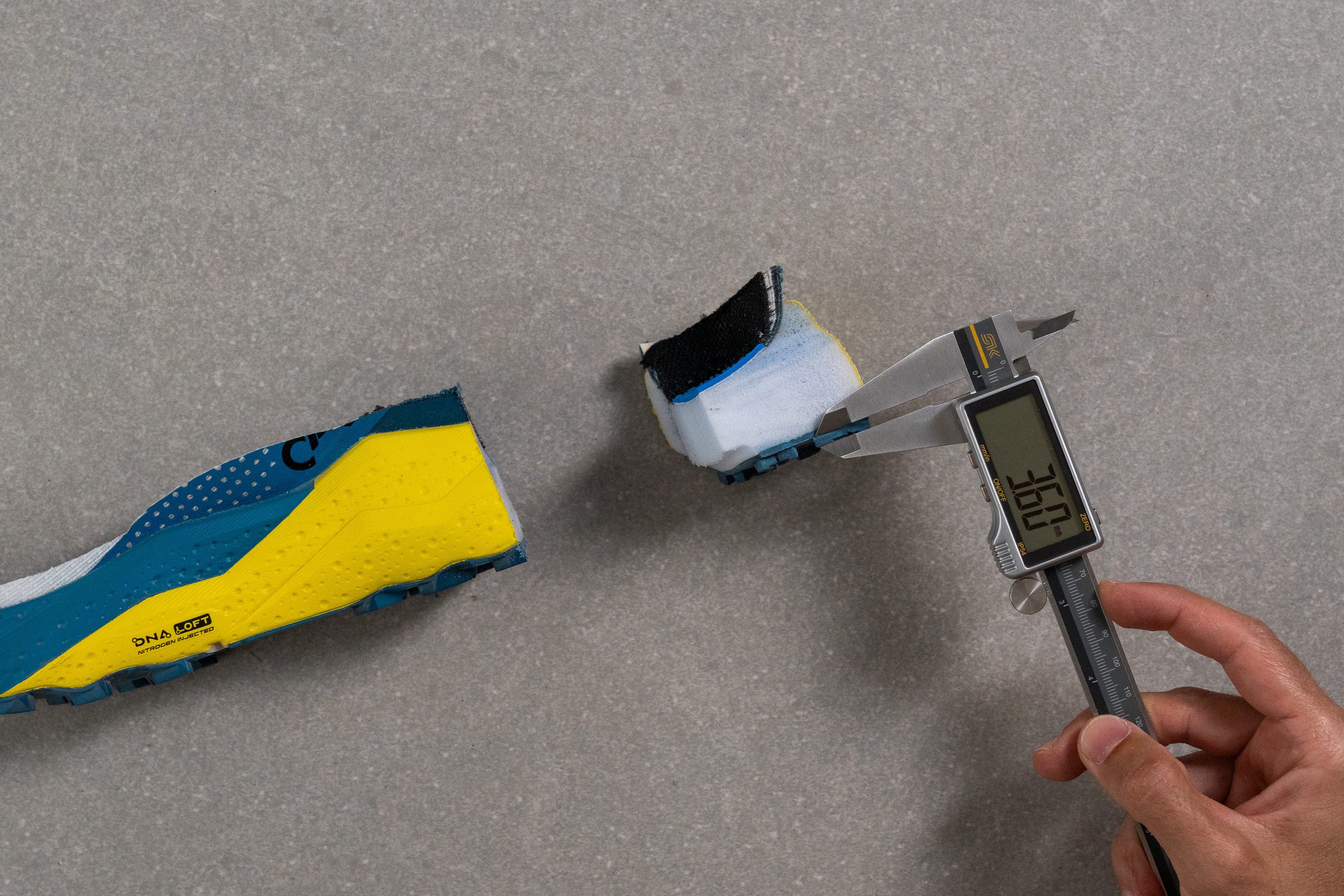
| Caldera 8 | 3.6 mm |
| Media | 3.5 mm |
Diseño de la suela exterior
La suela exterior de las Caldera 8 tiene los mismos tacos multidireccionales de la versión 7, un patrón diseñado para ofrecer un agarre seguro en terrenos distintos.
Descubrimos que el gran corte del medio reduce el peso e intenta aumentar la flexibilidad, mientras que los tacos en ángulo ofrecen una tracción constante en subidas, bajadas y terrenos inestables gracias a su orientación cuidadosamente diseñada.
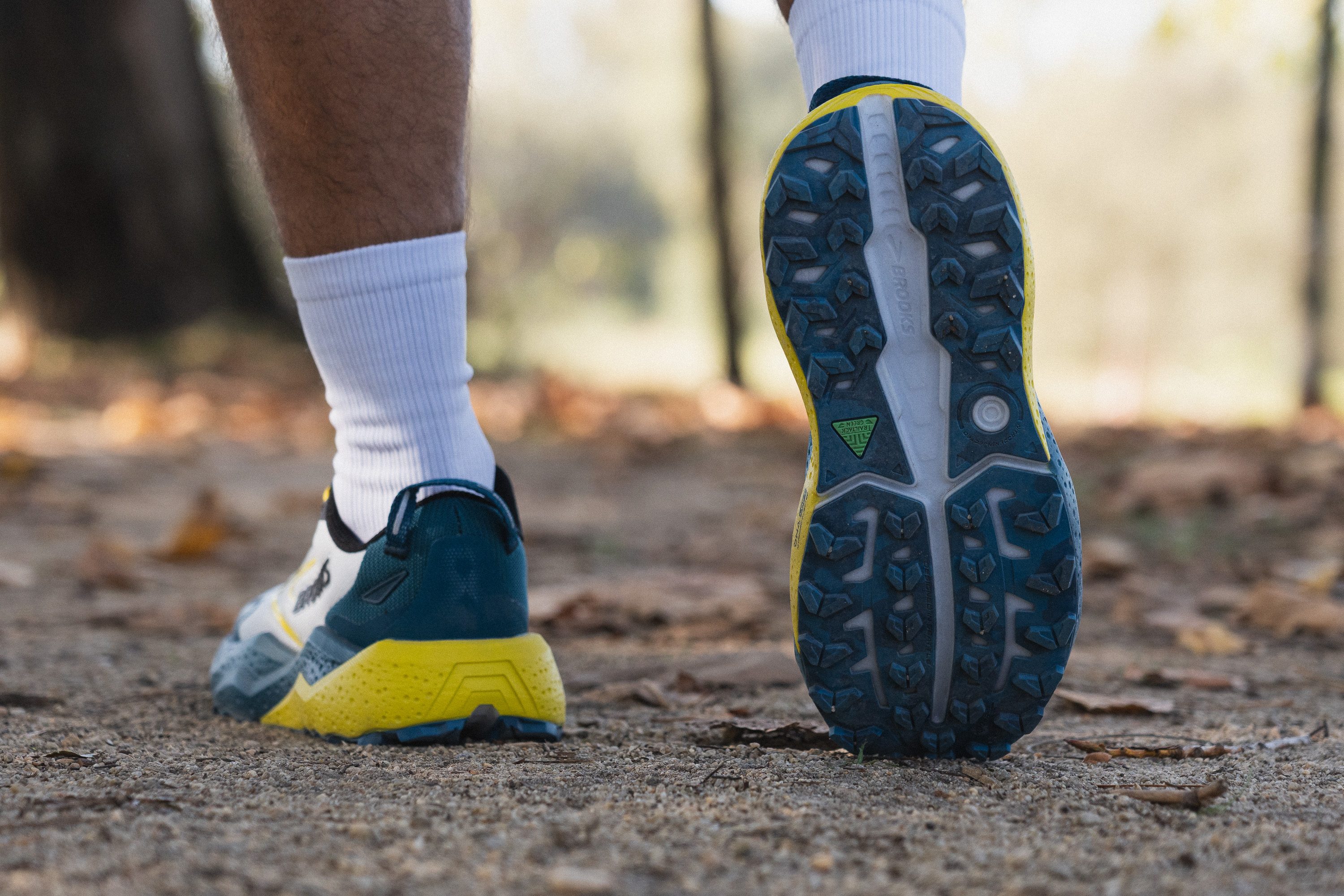
Flexibilidad / Rigidez
Como la suela exterior es idéntica a la de la v7 y la mediasuela casi no ha cambiado nada tampoco, su rigidez es muy parecida y moderadamente alta, de 17,0 N.

| Caldera 8 | 17.0N |
| Media | 14.6N |
Peso
Una característica que siempre ha definido a las Caldera es que son pesadas, y nuestra báscula nos dejó claro que eso tampoco ha cambiado. Con 309 g, creemos que Brooks debería utilizar materiales más ligeros o incluso una espuma distinta en el futuro.
Incluso así, dudamos que el peso sea un factor decisivo para la mayoría de los corredores que están pensando en comprarse las Caldera 8, aunque los que busquen una sensación más ligera a lo mejor sí que creen que son un poquito pesadas.
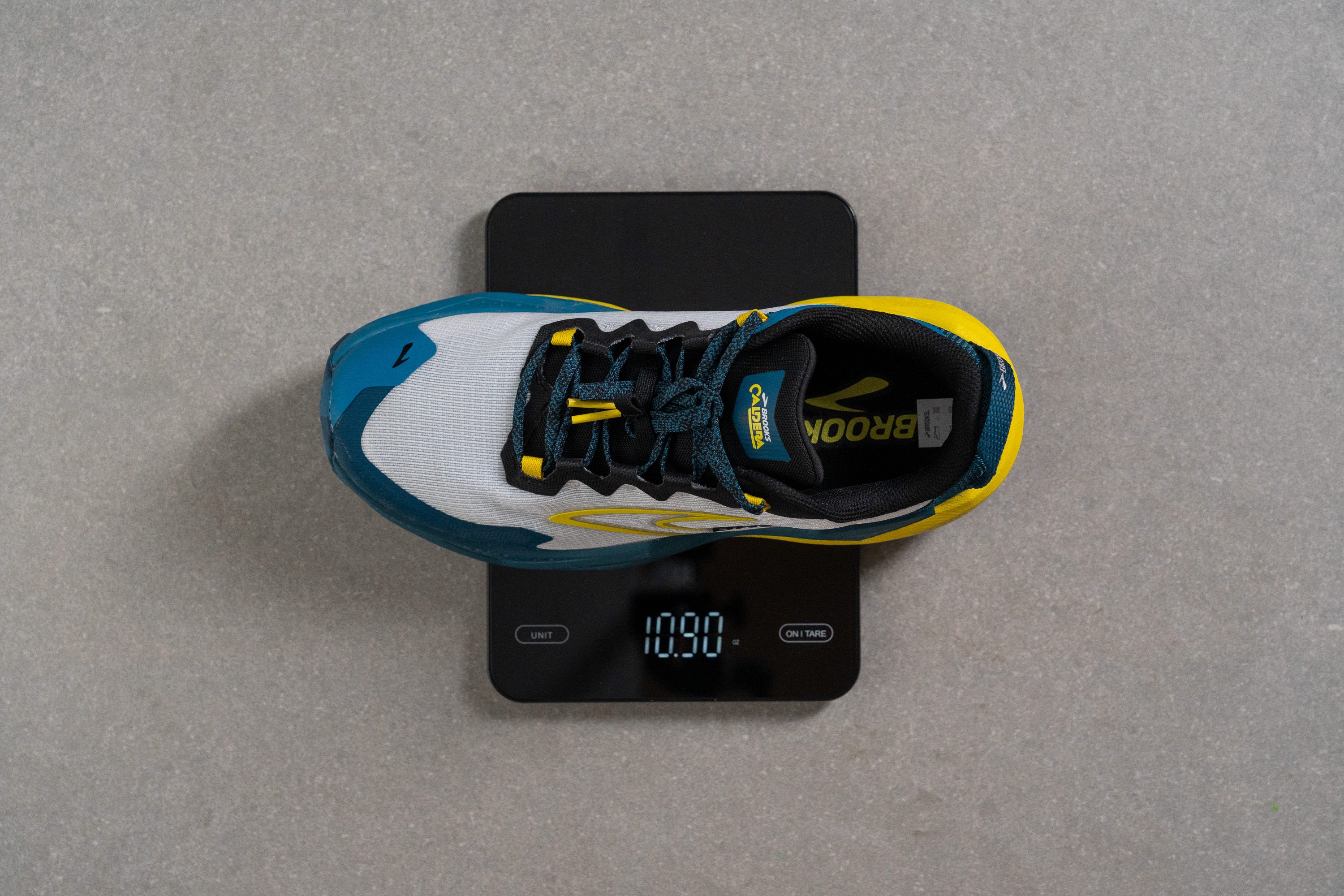
| Caldera 8 | 10.9 oz (309g) |
| Media | 10.2 oz (289g) |
Transpirabilidad
El upper de las Caldera 8 tiene un diseño resistente que reduce el flujo de aire en comparación con la media de las zapatillas de trail. Esta estructura tan robusta está pensada para protegerte de todo lo que se te ponga por delante, eso está claro.
Con la ayuda de nuestra máquina de humo, las analizamos y decidimos darles un 3/5 en transpirabilidad, que es resultado que nos parece perfectamente aceptable para esta categoría. Las zapatillas de trail no suelen necesitar los sistemas de ventilación avanzados que vemos en las zapatillas para correr por asfalto.
Una transpirabilidad baja puede venirte como anillo al dedo cuando hace frío, ya que hace que los corredores tengan los pies más calentitos y protegidos cuando salen a correr en invierno; y las Caldera 8 saben de lo que hablamos.

Como no tienen agujeros grandes para el flujo de aire, claramente su transpirabilidad no podía ser una locura.
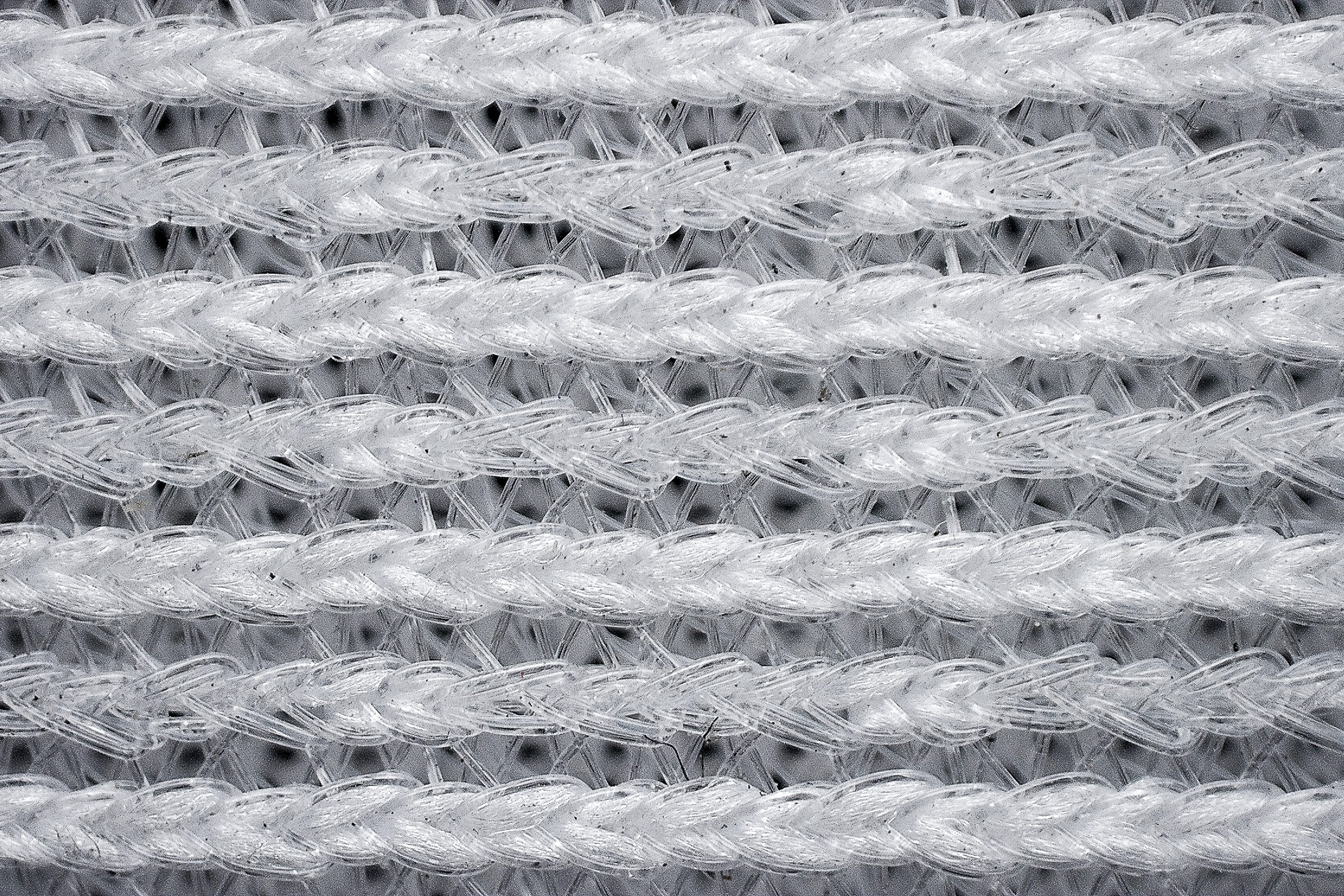
Gracias a nuestro microscopio digital, pudimos ver que el upper solo tiene unas aperturas diminutas en un tejido denso.
También estamos muy contentos de que sus materiales sean reciclados, y de que las zapatillas tengan la certificación CarbonNeutral.
| Caldera 8 | 3 |
| Media | 3.2 |
Estabilidad
Prueba de estabilidad lateral
Uno de los rasgos más distintivos de las Caldera 8 es su excelente estabilidad, que se la deben tanto a su anchísima mediasuela como a sus paredes laterales altas, que limitan los movimientos laterales excesivos (aunque sí que se pueden sentir un poco intrusivas, sobre todo para los corredores de mediopié).
Incluso así, para los corredores de trail que prefieren una pisada equilibrada y estable, y no les importa un poco de volumen extra, esta sigue siendo una opción muy sólida.
Rigidez torsional
Las Caldera 8 son casi imposibles de retorcer, alcanzando el nivel de las zapatillas que tienen una placa de carbono en su mediasuela. En nuestra prueba de rigidez torsional, se llevaron un 5/5 perfecto.
| Caldera 8 | 5 |
| Media | 3.6 |
Rigidez del contrafuerte del talón
El contrafuerte del talón también es bastante rígido, ya que se llevó un 4/5, pero Brooks le puso bastante espuma para equilibrarlo, manteniendo esta zona sorprendentemente cómoda incluso en las distancias largas.
| Caldera 8 | 4 |
| Media | 3 |
Anchura de la mediasuela - antepié
La anchura del antepié no es, ni muchísimo menos, extrema, ya que alcanza 116,6 mm según nuestro calibre. La verdad es que nos parece algo muy positivo, ya que hacerlo más ancho no sería tampoco muy beneficioso.
No te olvides de que la mayor parte de la estabilidad de unas zapatillas viene de cómo el talón y el mediopié se conectan con el antepié, y en las Caldera 8 ambas zonas ya son muy anchas, como verás en nuestra próxima prueba. Vamos, que añadir otros 5 o 10 mm en la parte delantera tampoco cambiaría la estabilidad de forma significativa.

| Caldera 8 | 116.6 mm |
| Media | 112.8 mm |
Anchura de la mediasuela - talón
El talón es muy ancho, con sus 104,0 mm. Esto hace que las Caldera 8 estén junto a las Caldera 6 y a las 7 en el grupo de los modelos más anchos que hemos analizado, y solo son un poquito más estrechas que las HOKA Stinson 7.
En nuestra opinión, esta plataforma tan grandota puede ser demasiado para los corredores que no dependen de la estabilidad del talón, sobre todo los que aterrizan con el mediopié o el antepié. Por eso creemos que las Caldera 8 son más adecuadas para los talonadores, que son los que realmente se benefician de toda esa anchura en la parte de atrás del pie.

| Caldera 8 | 104.0 mm |
| Media | 89.9 mm |
Durabilidad
Durabilidad de la parte delantera
Resulta que la protección de la parte delantera de las Caldera 8 tiene un diseño poco convencional, ya que utiliza una capa de TPU asimétrica y muy protectora que se centra en el dedo gordo, dejando más expuesta la parte delantera de las zapatillas. Cuando analizamos esta estructura, la verdad es que nos pareció un poco problemática, y se llevó solo un 2/5 en nuestra prueba de durabilidad.
| Caldera 8 | 2 |
| Media | 3.1 |
Durabilidad del acolchado del talón
El acolchado del talón rindió mucho mejor, llevándose un sólido 4/5 y dejándonos claro que esta zona no terminará hecha polvo más pronto que tarde.
| Caldera 8 | 4 |
| Media | 3 |
Durabilidad de la suela
También descubrimos que el caucho TrailTack Green es duradero. No podemos decir que sea una armadura, pero terminó con solo 1,0 mm de desgaste, así que debería tener fácilmente la vida útil propia de los modelos de trail running.
| Caldera 8 | 1.0 mm |
| Media | 0.9 mm |
Grosor de la suela
La suela exterior es bastante finita, con un grosor de 1,9 mm, probablemente porque las zapatillas ya son bastante pesadas de por sí, y la capa gruesa de espuma ofrece mucha protección contra las piedrecillas y otros obstáculos del camino.

| Caldera 8 | 1.9 mm |
| Media | 2.2 mm |
Varios
Grosor de la plantilla
La plantilla le suma 4,9 mm de espuma EVA a la altura total de las zapatillas.
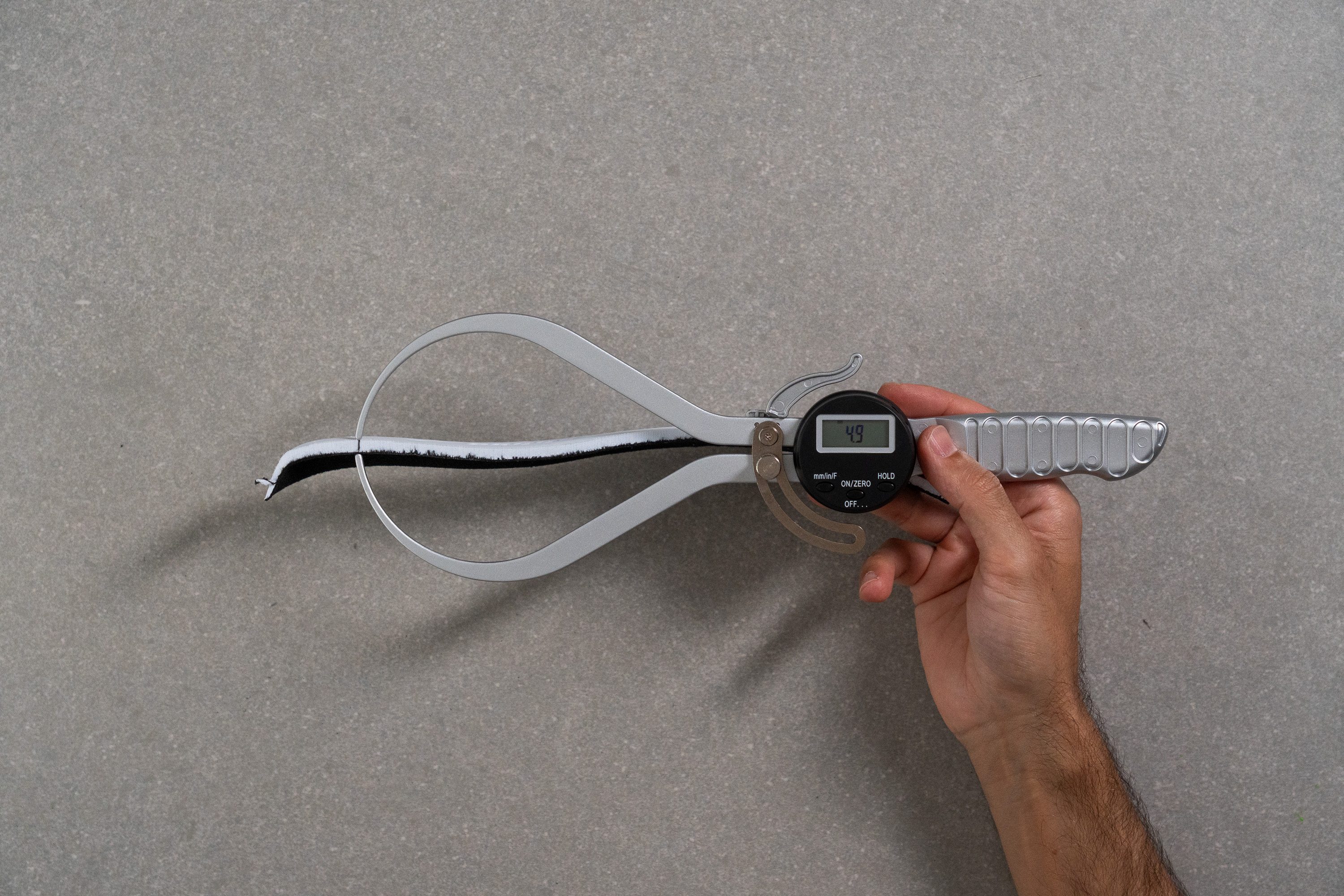
| Caldera 8 | 4.9 mm |
| Media | 4.7 mm |
Plantilla extraíble
Descubrimos que puedes cambiar la plantilla original por otra sin problema. La verdad es que nos sorprendió ver una plantilla normal en lugar de una con agujeritos, como en la serie Cascadia.

| Caldera 8 | Sí |
Rigidez de la mediasuela en frío (%)
La mediasuela DNA Loft v3 es de EVA, así que no nos esperábamos mucho si hablamos de su rendimiento cuando hace frío, y eso fue justo lo que pasó. Se volvió un 42 % más firme, así que no te esperes que sea blandita cuando bajen las temperaturas.

| Caldera 8 | 42% |
| Media | 26% |
Elementos reflectantes
Brooks no les ha puesto elementos reflectantes a sus modelos de trail más recientes, cosa que nos decepciona un poco, la verdad.
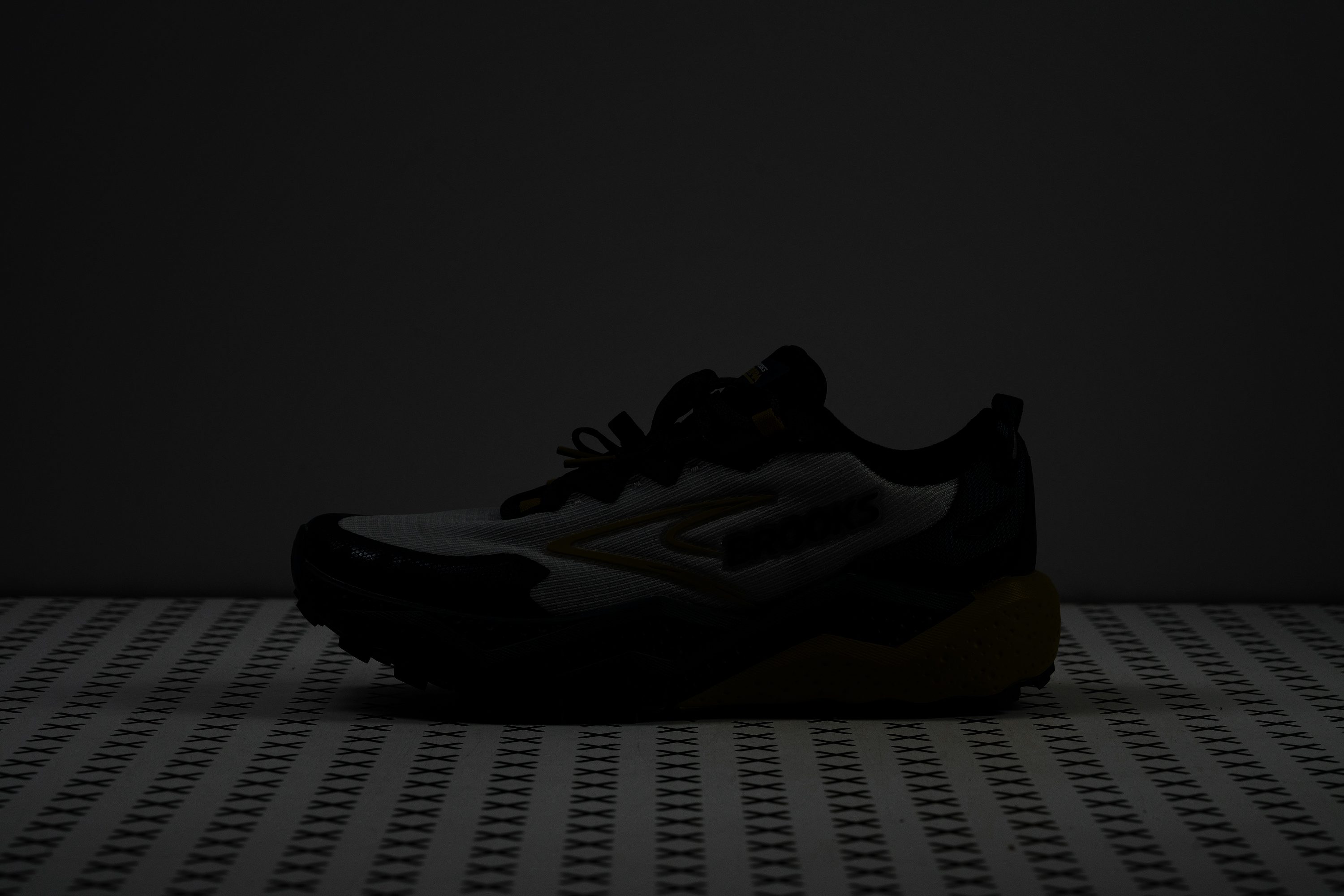
| Caldera 8 | No |
Acolchado de la lengüeta
Las Caldera 8 tienen un sistema de cordones mixto con lacitos que mejoran tanto la sujeción como el ajuste. Los ojales de arriba y de abajo utilizan lazos de color amarillo brillante, mientras que el resto utiliza lazos integrados que ajustan el mediopié de forma firme y uniforme. Un detalle que nos encantó fue la banda elástica, que mantiene los cordones perfectamente en su sitio y evita que estén bailando por ahí.
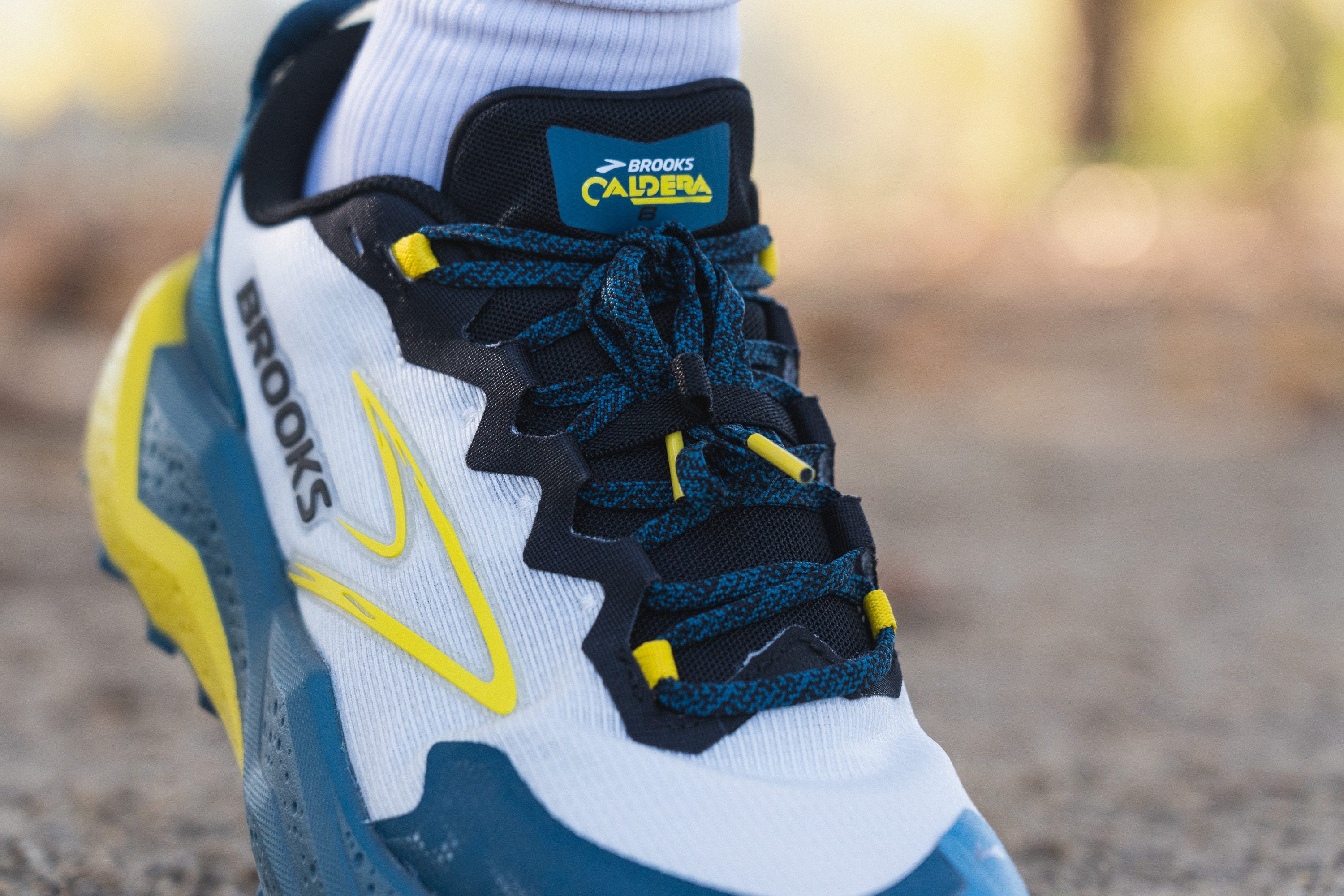
La lengüeta es otra pieza que nos queda claro que estas zapatillas tienen un problema en cuanto al peso, ya que su acolchado es de solo 5,0 mm. Para nosotros es suficiente, pero en comparación con otros modelos centrados en la comodidad, a lo mejor se queda un poco corta.
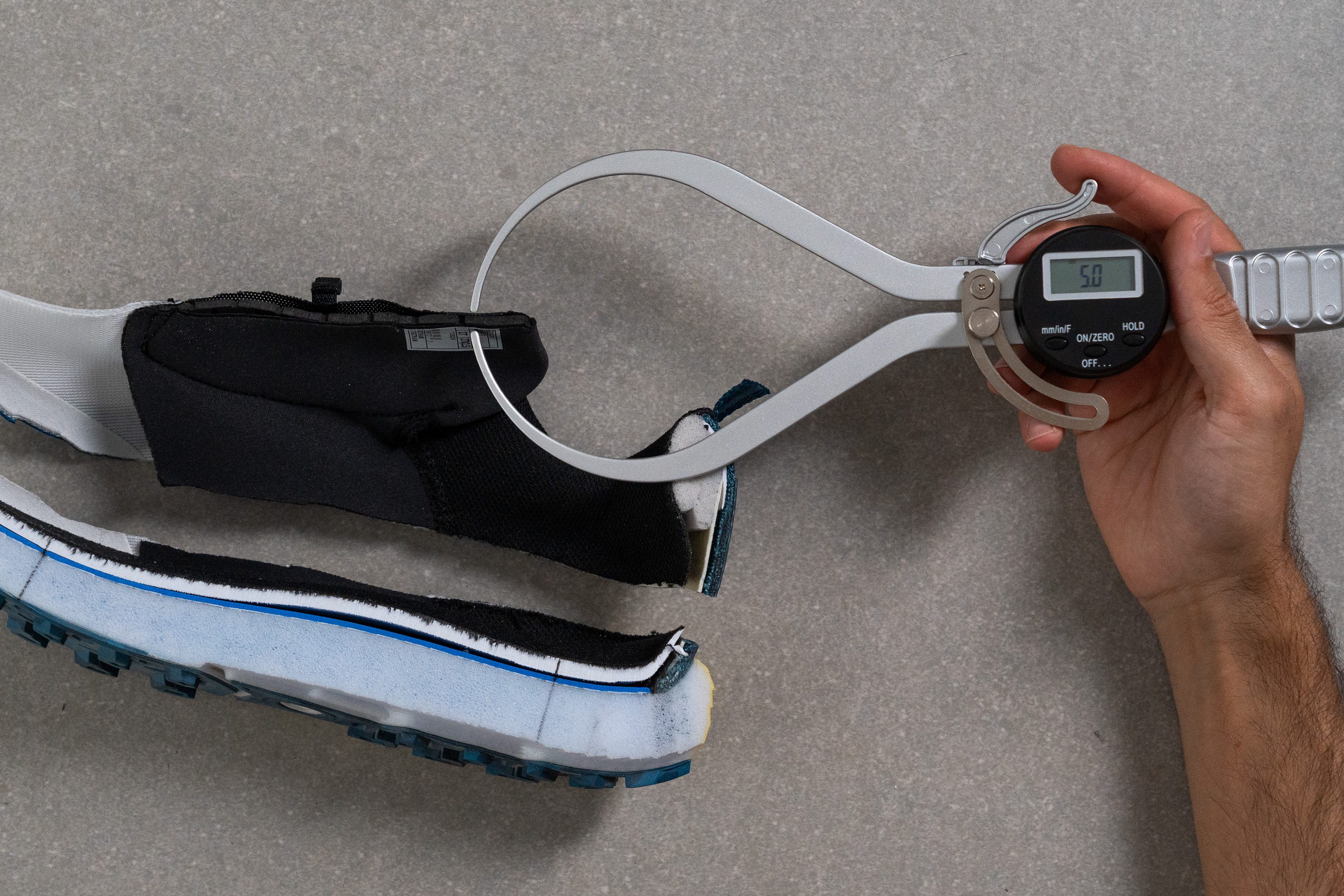
| Caldera 8 | 5.0 mm |
| Media | 6.4 mm |
Lengüeta: tipo de refuerzo
La lengüeta está semi reforzada, y no hay problema, pero para las zapatillas de trail... creemos que un diseño completamente reforzado que avaya hasta el final te protege más.
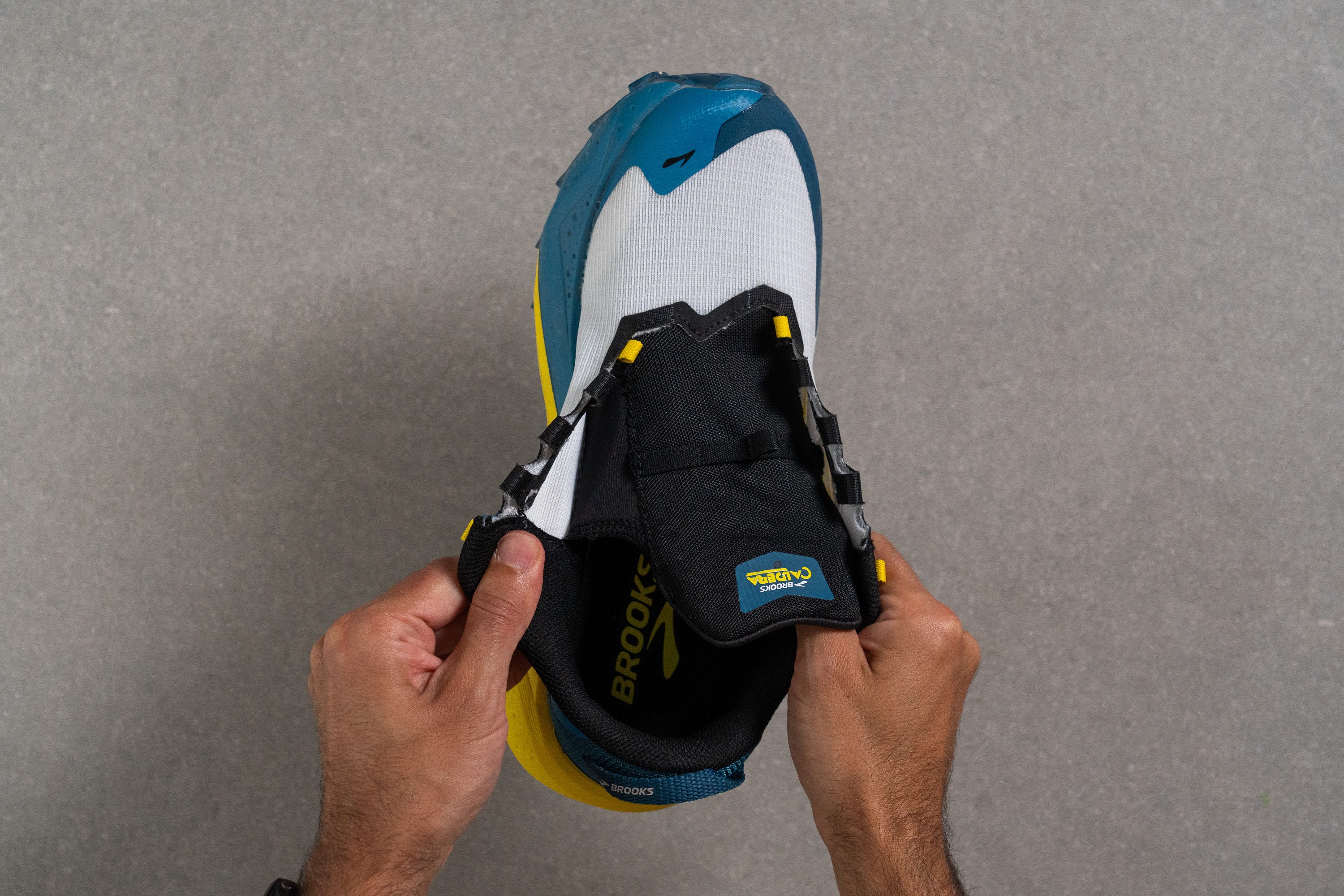
| Caldera 8 | Ambos lados (semi) |
Precio
Las Brooks Caldera 8 mantienen el mismo precio razonable que sus predecesoras, y creemos que está justificado. Incluso así, creemos que necesitaría dar un salto en cuanto a tecnologías para diferenciarse mejor de las Cascadia, incluso si eso implica que sean algo más caras. Que sí, que sí, ¡que por una vez no nos quejaríamos por pagar un poquito más!
| Caldera 8 | $150 |
Tirador del talón
Las Caldera 8 tienen un tirador práctico y fácil de agarrar. La verdad es que nos gusta más que el que tienen las Cascadia, ya que se siente más sólido y duradero, lo que nos da confianza de que resistirá mejor con el tiempo.
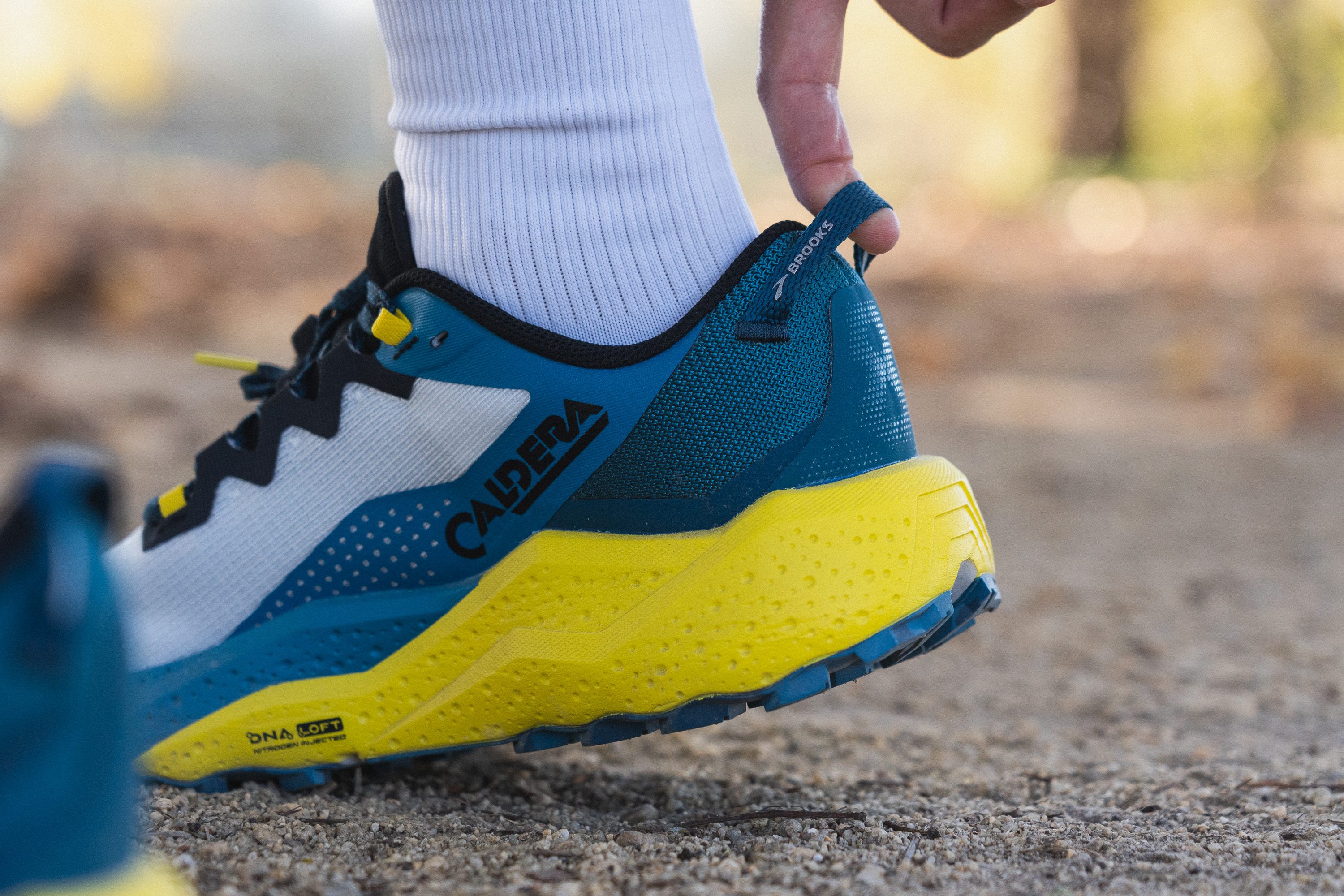
| Caldera 8 | Tirador circular |

